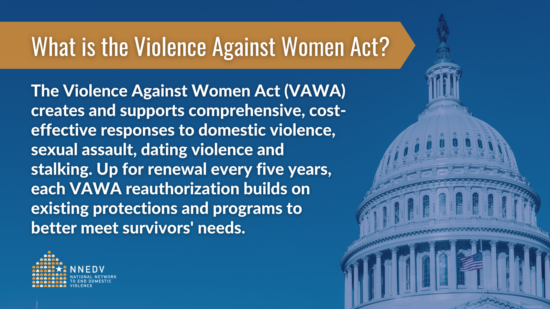Violence Against Women Act
The Violence Against Women Act (VAWA) creates and supports comprehensive, cost-effective responses to domestic violence, sexual assault, dating violence and stalking. Since its enactment in 1994, VAWA programs, administered by the U.S. Departments of Justice (DOJ) and Health and Human Services (HHS), have dramatically improved federal, tribal, state, and local responses to these crimes.

The VAWA Reauthorization Act of 2022 was included in the fiscal year 2022 omnibus spending package signed by President Joseph R. Biden on March 15, 2022. This bipartisan VAWA reauthorization includes groundbreaking provisions to strengthen and modernize the law. The law provides survivors, the thousands of local programs that serve them, and communities with much-needed resources for housing, legal assistance, alternatives to criminal responses, and prevention programming. The law also restores tribal jurisdiction, allowing tribes to hold non-Native perpetrators accountable, improves existing housing protections and increases access to emergency and short-term housing, and creates dedicated investments in culturally specific service providers to ensure survivors of color are supported.
History and Background
The original Violence Against Women Act, passed in 1994, was the first federal legislation acknowledging domestic violence and sexual assault as crimes and provided federal resources to encourage community-coordinated responses to combating violence against women. (Learn more here about NNEDV’s role in passing the original VAWA.)
Up for renewal every five years, each VAWA reauthorization has built on existing protections and programs to better meet the needs of survivors. Read more about previous VAWA reauthorizations:
2000
The first VAWA reauthorization, in 2000, created a much-needed legal assistance program for victims and included responses to dating violence and stalking. It reauthorized critical grant programs and subsequent legislation, established new grant programs, and strengthened federal law. It also reinforced the role of state and territorial domestic violence coalitions in coordinating advocacy and services for survivors.
2005
In 2005, VAWA’s reauthorization produced new, holistic responses and programs to meet the emerging needs of survivors and communities, such as prevention, landmark housing protections for survivors, funding for rape crisis centers, and culturally and linguistically specific services.
2013
In 2013, VAWA’s reauthorization enhanced access to safety and justice for Native women, immigrants, college students and youth, and public housing residents. It also strengthened non-discrimination protections to help ensure all survivors are supported.
Additional Resources
NNEDV works closely with allied organizations and experts to develop and implement the housing provisions in VAWA. Learn more from our Housing team.

